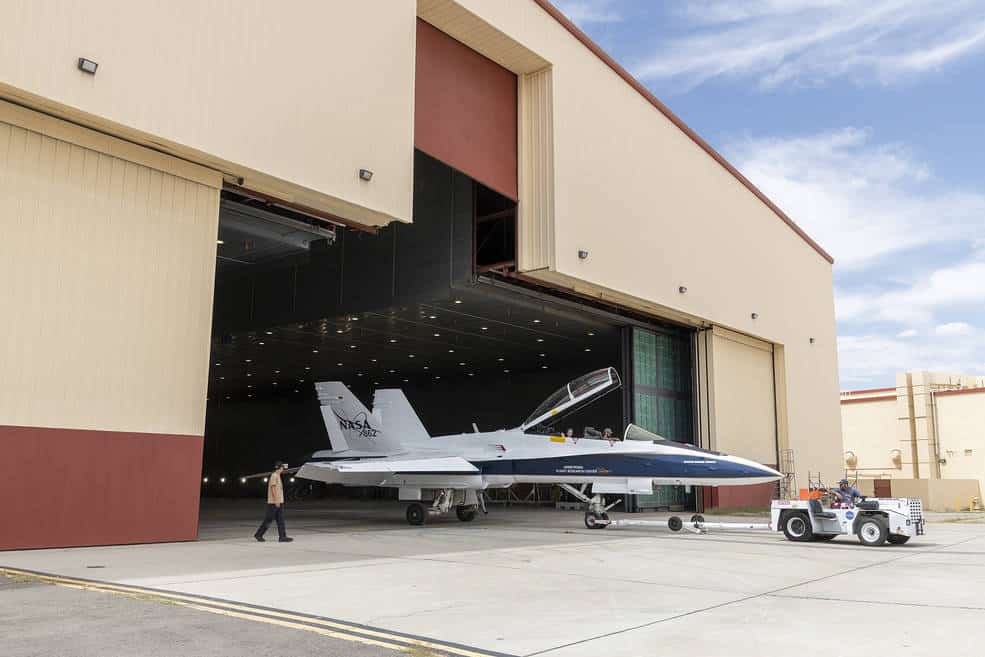Aerospace
F/A-18 Hornet Joins NASA-Owned F-15 to Chase After the X-59 Supersonic Aircraft

A F/A-18 aircraft that NASA purchased from the U.S. Navy in 2021 has undergone a thorough reconstruction according to NASA. In order to follow or “chase” the supersonic X-59 aircraft, this rejuvenated aircraft will join the Armstrong Flight Research Center’s fleet.
NASA is presently building the supersonic X-59 QueSST aircraft to show its dedication to cutting-edge aeronautical research. The installation of an engine in the X-59 marked an important project milestone in November 2022.
Additionally, it was revealed in January 2023 that the X-59’s first flight is planned to take place by the end of 2023, representing a significant advancement in NASA’s quest for supersonic flight capabilities.
NASA first stated it would make use of an F-15 in 2021. This aircraft will track the X-59 as it travels at supersonic speeds in an effort to measure and display the sound waves it generates. The F-15, run by NASA, has a gadget on its nose that allows it to maintain a close enough distance for that to occur. The Airborne Location Integrating Geospatial Navigation System (ALIGNS) was created to make it possible for the fighter plane’s pilot to coordinate maneuvers while flying behind the target at supersonic speeds.
It turns out that the F-15 is not sufficient for data collection on its alone. Both the Eagle and the Super Hornet will pursue the X-59. NASA will use the F/A-18D as a platform for photographers and videographers who will attempt to capture supersonic flight.
The aircraft underwent an overhaul procedure required after a certain amount of flight hours in order to participate in NASA Armstrong missions. This included removing the wings, inspecting for corrosion, modernizing systems, and performing other critical checks and service.

Aerospace
When Ratan Tata was denied entry to the airfield at the Aero India show, he waited

During our visit to Aero India 2019, we had the unexpected opportunity to see Ratan Tata at the event, which was a thrilling moment for us. However, there was a surprising hiccup when the security staff didn’t allow him to enter due to a lack of a security pass.
Despite this, he remained calm and patiently waited for about 20 minutes until a member of the Tata team brought him the required pass, after which he calmly proceeded inside. It was a humbling sight, showcasing his composed demeanor even in such situations.
Ratan Tata ji is not only a renowned industrialist but also a trained pilot, holding a pilot’s license. In 2007, he became the first Indian civilian to fly the F-16 Falcon during the Aero India show in Bangalore—a proud moment for the nation.
His passion for aviation extended beyond flying, as he played a key role in shaping India’s aerospace industry. Under his leadership, Tata ventured into manufacturing and maintaining aerospace components while upholding its legacy of quality. Notably, Tata’s collaboration with Airbus to develop and manufacture the C295 aircraft is a testament to its growing influence in the sector.
-

 Aviation2 months ago
Aviation2 months agoMicrosoft Flight Simulator Raises $3 Million to Bring Back the An-225 Mriya
-

 Airlines2 months ago
Airlines2 months agoQatar Citizens Can Travel to the United States Without a Visa
-

 Aviation2 months ago
Aviation2 months agoQatar Airways bans these new Electronic Devices on plane
-

 Airlines2 months ago
Airlines2 months agoJapan Airlines Rolls Out Free Domestic Flights to International Passengers
-

 Defence2 months ago
Defence2 months agoWhich Country Has the Largest Fleet of Fighter Aircraft?
-

 Airport2 months ago
Airport2 months agoWestern Sydney Airport Welcomes Its First Plane After 6 Years of construction
-

 Travel2 months ago
Travel2 months agoQatar Airways Launches Four Additional Flights from Amsterdam
-

 Aviation2 months ago
Aviation2 months agoDid you know ? Once Boeing 747 carried 1088 passenger in 1991








